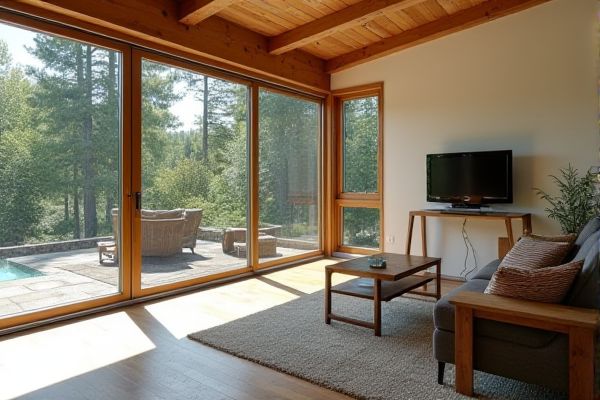
Retractable screens offer flexibility by allowing you to easily open or close the screen as needed, ideal for preserving views and maximizing airflow, while permanent screens provide continuous protection and durability suited for long-term use. Explore the rest of the article to determine which screen type best fits your lifestyle and needs.
Table of Comparison
| Feature | Retractable Screen | Permanent Screen |
|---|---|---|
| Installation | Easy to install, no structural changes needed | Requires fixed framework, may need structural work |
| Space Efficiency | Disappears when not in use, saves space | Always visible, occupies permanent space |
| Durability | Moderate; moving parts may require maintenance | High; fixed and sturdy construction |
| Aesthetics | Sleek, modern look; hides when retracted | Traditional appearance; always on display |
| Cost | Typically higher initial cost due to mechanism | Generally lower cost, simpler design |
| Functionality | Provides flexible use; deploy only when needed | Constant protection; no deployment needed |
| Maintenance | Requires occasional cleaning and mechanism checks | Minimal; mainly cleaning |
| Ideal Use | Doors, windows requiring occasional screen | Areas needing permanent insect protection |
Introduction to Retractable and Permanent Screens
Retractable screens offer flexibility by allowing users to extend or retract the screen as needed, providing protection against insects without permanent obstruction of views or airflow. Permanent screens are fixed installations that provide continuous barrier protection, ideal for areas requiring constant coverage and durability. Choosing between retractable and permanent screens depends on usage frequency, aesthetic preference, and maintenance considerations.
Key Differences Between Retractable and Permanent Screens
Retractable screens offer the flexibility of being hidden when not in use, preserving the aesthetic of doors or windows and reducing wear by protecting the screen material from the elements. Permanent screens provide a durable, fixed barrier that consistently prevents insects and debris from entering, making them suitable for areas with high pest activity or frequent use. Material and installation methods differ significantly; retractable screens often use lightweight mesh and track systems for smooth operation, while permanent screens are typically installed with sturdy frames for long-term stability.
Pros and Cons of Retractable Screens
Retractable screens offer the advantage of flexibility, allowing you to enjoy an unobstructed view and easy access when the screen is not needed, making them ideal for seasonal use or varying weather conditions. These screens typically require less maintenance, reduce wear and tear, and can be neatly stored away, but they may have higher initial costs and potentially less durability compared to permanent screens. While permanent screens provide constant protection from insects and debris, retractable options give you customizable control over your living space's openness and ventilation.
Pros and Cons of Permanent Screens
Permanent screens provide durable protection against insects and debris, enhancing home security and reducing maintenance with their fixed, sturdy frames. However, they limit your ability to fully open windows or doors, potentially reducing ventilation and outdoor views. Your choice depends on balancing long-term durability and security with flexibility and ease of access.
Installation Process: Retractable vs Permanent Screens
Retractable screens feature a straightforward installation process, often requiring minimal tools and allowing for quick mounting that can be completed by homeowners without specialized skills. Permanent screens demand a more complex installation involving precise measurements, hardware fitting, and sometimes professional assistance to ensure durability and seamless integration with your window or door frame. Choosing between retractable and permanent screens depends on your preference for flexibility versus long-term stability in screen setup.
Durability and Maintenance Comparison
Retractable screens offer flexibility and ease of maintenance by allowing you to roll them away, reducing exposure to environmental wear and tear. Permanent screens are typically more durable due to their fixed installation and sturdier frame but may accumulate dirt and debris more quickly, requiring regular cleaning. Choosing between the two depends on your preference for longevity versus convenience in upkeep.
Aesthetics and Design Flexibility
Retractable screens offer superior aesthetics and design flexibility by remaining hidden when not in use, preserving your space's clean and modern look. Permanent screens provide a constant visual element that can be customized with various materials and styles but may limit adaptability in changing decor. Choosing between the two depends on your preference for seamless integration versus a fixed design statement.
Cost Analysis: Initial Investment and Long-term Value
Retractable screens typically require a higher initial investment due to advanced mechanisms and premium materials, while permanent screens offer a more affordable upfront cost but may need frequent replacements or repairs. Over time, retractable screens provide better long-term value through durability and ease of maintenance, reducing ongoing expenses and preserving your home's aesthetic appeal. Evaluating both options based on installation costs, lifespan, and maintenance needs ensures a cost-effective decision that aligns with your budget and usage requirements.
Suitability for Different Architectural Styles
Retractable screens offer versatile adaptability, seamlessly integrating with modern, minimalist, and contemporary architectural styles by remaining hidden when not in use. Permanent screens provide a consistent, structured appearance that complements traditional, colonial, and craftsman-style homes, enhancing their classic aesthetic. Choosing between retractable and permanent screens depends on the desired visual impact and architectural coherence.
Which Screen Type Is Best for Your Needs?
Retractable screens offer flexibility and space-saving benefits, making them ideal for occasional use or areas where the screen needs to be hidden when not in use. Permanent screens provide durability and consistent protection, suitable for high-traffic areas or long-term installations requiring sturdy insect barriers. Evaluating factors such as usage frequency, aesthetic preferences, and installation location will help determine whether a retractable or permanent screen best suits your needs.
 homyna.com
homyna.com